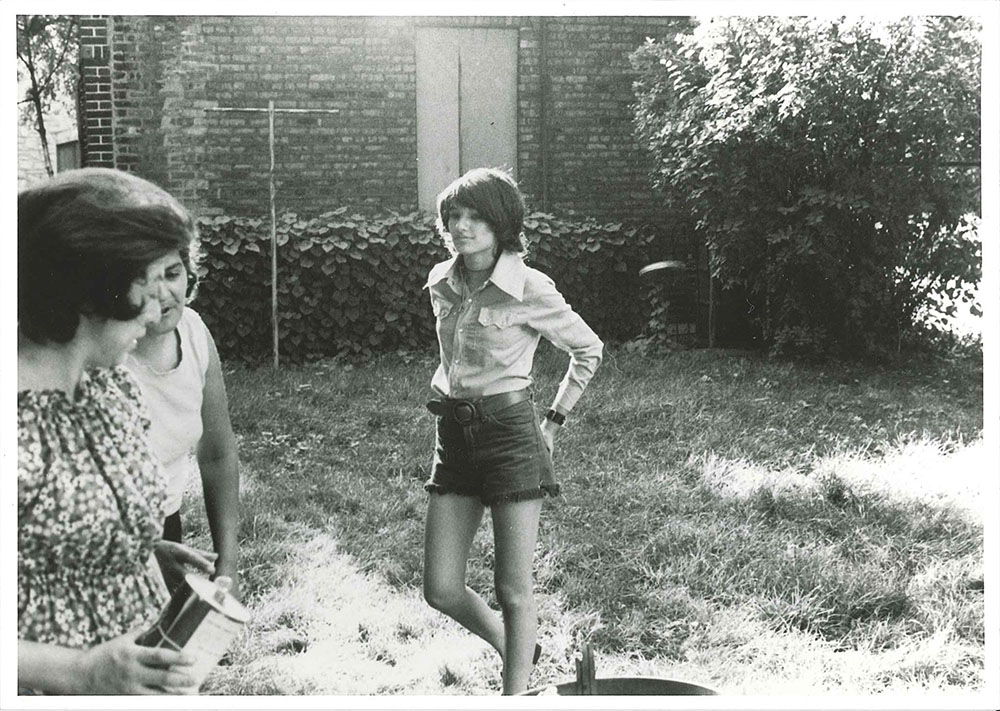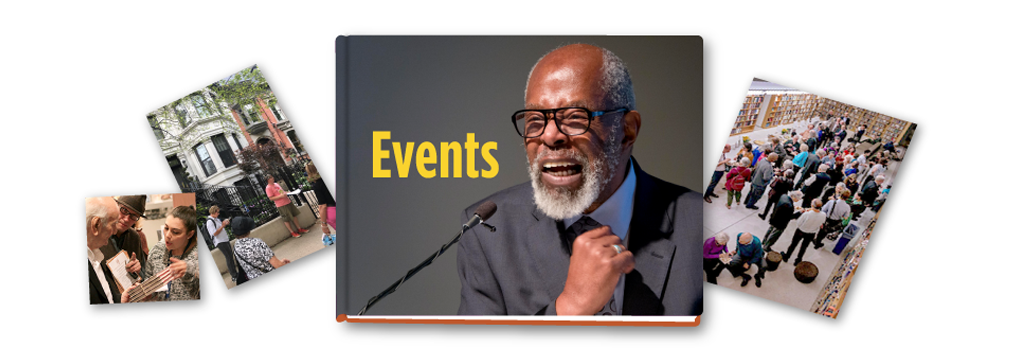Sandra Cisneros's Real House, Like the One on Mango Street
by Donald G. Evans and Angie Raney

A young Sandra in the backyard of the original house at 1525 North Campbell Avenue.
1525 North Campbell Avenue, Chicago, IL 60622
In 1965, an eleven-year-old Sandra Cisneros and her family moved into the residence at 1525 N. Campbell Avenue. This address was one of Cisneros’ multiple childhood residences and is said to have been the real-life inspiration for the house on Mango Street, from which the book receives its title. The house is nestled within a Humboldt Park neighborhood that today still reflects the diversity explored in The House on Mango Street, which is set around the 1960s. Latinos, especially Puerto Ricans, Mexicans, and Dominicans, comprise more than half the neighborhood’s population. Unfortunately, the original house at 1525 North Campbell Ave. was demolished around 2004; a modern three-flat apartment building now stands in its place. However, Cisneros herself stated that the house that stands directly across from 1525 is very similar to her childhood home. This house is “small and red with tight steps in front and windows so small you’d think they were holding their breath,” just as it is described in the title story of The House on Mango Street. That story goes on to say, “Bricks are crumbling in places, and the front door is so swollen you have to push hard to get in. There is no front yard, only four little elms the city planted by the curb.” A later story observes the house “with its feet tucked under like a cat.”
The fictional Mango Street, especially narrator Esperanza’s own house, is described in intricate detail throughout the 46 vignettes that comprise the collection. The story, “Alicia & I Talking on Edna’s Steps” pins down an address. “You live right here 4006 Mango, Alicia says and points to the house I am ashamed of.” There is no actual Mango Street in Chicago, but there is a Mango Avenue. It is between Central and Austin, and of course, 4006 would be just off Irving Park Road.
Cisneros writes in A House of My Own, that while the Mango Street house was actually modeled after one specific past Chicago residence, the fictional neighborhood is a potpourri of details based on other places she’d lived. She writes, “I pick up parts of Bucktown, like the monkey garden next door, and plop it down in the Humboldt Park block where I lived during my middle and high school years—1525 N. Campbell Street."
The fictional Mango Street is a poor neighborhood populated with immigrant families and colorful characters, a neighborhood that Cathy Queen of Cats warns is changing for the worse, prompting Esperanza to comment, “…they’ll just have to move a little farther north from Mango Street, a little farther away every time people like us keep moving in.” It is not a transient neighborhood, exactly, but more a neighborhood of last resort in which residents, including Esperanza’s family, move in with the intention of moving out. Friends and neighbors come and go—for example, Cathy, whose father built her wooden house with slanty floors and no closets, is replaced by Meme Ortiz. Esperanza and friends stage the First Annual Tarzan Jumping Contest in Meme’s dirt backyard, amidst its collapsed remnants of an old garage and a big tree.
The neighborhood is densely populated, as lots of people cram into the street’s houses and apartment buildings, like the Puerto Rican family who lives in Meme’s basement apartment, and Rose Vargas’ wild kids who are described as “too many and too much.” Edna owns the big six-flat next door, with daughter Ruthie as one tenant and jukebox repairman Earl and his two dogs staying in the basement. Benny and Bianca own the corner candy store. Elenita, the “witch woman,” reads fortunes in a kitchen somewhere nearby. Mamacita lives across the street, third-floor front.
The narrator, though barely an adolescent, understands that her neighborhood is considered undesirable. She writes, in “Those Who Don’t,” about that reputation. “Those who don’t know any better come into our neighborhood scared. They think we’re dangerous. They think we will attack them with shiny knives.” Among the Mango Street denizens, there are unwed mothers, petty thieves, drug abusers, and a garden variety of mischief-makers.
Esperanza does wander off Mango Street from time to time, especially to “the avenue which is dangerous. Laundromat, junk store, drugstore, windows and cars, and more cars…” This likely refers to North Avenue, which would have been the busiest street near the fictional home and its model. Gil, “a black man who doesn’t talk much,” owns the junk shop. Esperanza’s school is just south of “the boulevard.”
Cisneros was born in Chicago on December 20, 1954. One of seven children and the family's only girl, the Cisneros’ moved between Chicago and Mexico City all throughout her childhood. Because of this nomadic upbringing, Cisneros began to view the idea of home not necessarily as the place one is born, but where someone comes into their own—a concept that would be prevalent in her future literary endeavors. As stated in her memoir A House of My Own, “Sometimes I was living on a grant. Sometimes I was living in a borrowed house or guest room. Sometimes I convinced myself I was in love, but most of the time I lived in a space that wasn’t mine with bills that flared like small fires. That meant I passed through a lot of houses, loves, and typewriters, never quite finding the right one.”
Cisneros found comfort and stability in the pages of the books she read at her local Chicago Public Libraries. Shy and introverted, Cisneros was an active and talented writer from a young age. However, in interviews, as well as her memoir, Cisneros states that it was not until her first-ever creative writing class at Loyola University in her junior year that she found her inspirational spark for creative writing. In 1973, Cisneros graduated from Josephinum High School in Wicker Park and further studied English at Loyola University. Years later, in 1978, Cisneros obtained her M.F.A. in creative writing from the University of Iowa Writers’ Workshop.
At that time, men had written nearly all the stories of her community; Cisneros wanted to add a perspective she knew was unique. In an interview with writer Martha Satz, Cisneros says, “I have lived in the barrio, but I discovered later on in looking at works by my contemporaries that they write about the barrio as a colorful, Sesame Street-like, funky neighborhood. To me, the barrio was a repressive community. I found it frightening and very terrifying for a woman. The future for women in the barrio is not a wonderful one. You don’t wander around these ‘mean streets.’ You stay at home. If you have to get somewhere, you take your life into your hands. So I wanted to counter those colorful viewpoints, which I’m sure are true to an extent but were not true for me.”
Cisneros was inspired by writers such as Carl Sandburg and Gwendolyn Brooks, both Chicago poets and writers whose pieces show the beautiful, troubling, realistic, and rewarding lives of the Chicago people. Referring to Brooks’s 1960 poem, “The Bean Eaters,” Cisneros wrote in her memoir, “I knew plenty of bean eaters too, but they lived in the Mexican communities of Pilsen, Humboldt Park, Little Village or Logan Square."
In 1965, an eleven-year-old Sandra Cisneros and her family moved into the residence at 1525 N. Campbell Avenue. This address was one of Cisneros’ multiple childhood residences and is said to have been the real-life inspiration for the house on Mango Street, from which the book receives its title. The house is nestled within a Humboldt Park neighborhood that today still reflects the diversity explored in The House on Mango Street, which is set around the 1960s. Latinos, especially Puerto Ricans, Mexicans, and Dominicans, comprise more than half the neighborhood’s population. Unfortunately, the original house at 1525 North Campbell Ave. was demolished around 2004; a modern three-flat apartment building now stands in its place. However, Cisneros herself stated that the house that stands directly across from 1525 is very similar to her childhood home. This house is “small and red with tight steps in front and windows so small you’d think they were holding their breath,” just as it is described in the title story of The House on Mango Street. That story goes on to say, “Bricks are crumbling in places, and the front door is so swollen you have to push hard to get in. There is no front yard, only four little elms the city planted by the curb.” A later story observes the house “with its feet tucked under like a cat.”
The fictional Mango Street, especially narrator Esperanza’s own house, is described in intricate detail throughout the 46 vignettes that comprise the collection. The story, “Alicia & I Talking on Edna’s Steps” pins down an address. “You live right here 4006 Mango, Alicia says and points to the house I am ashamed of.” There is no actual Mango Street in Chicago, but there is a Mango Avenue. It is between Central and Austin, and of course, 4006 would be just off Irving Park Road.
Cisneros writes in A House of My Own, that while the Mango Street house was actually modeled after one specific past Chicago residence, the fictional neighborhood is a potpourri of details based on other places she’d lived. She writes, “I pick up parts of Bucktown, like the monkey garden next door, and plop it down in the Humboldt Park block where I lived during my middle and high school years—1525 N. Campbell Street."
The fictional Mango Street is a poor neighborhood populated with immigrant families and colorful characters, a neighborhood that Cathy Queen of Cats warns is changing for the worse, prompting Esperanza to comment, “…they’ll just have to move a little farther north from Mango Street, a little farther away every time people like us keep moving in.” It is not a transient neighborhood, exactly, but more a neighborhood of last resort in which residents, including Esperanza’s family, move in with the intention of moving out. Friends and neighbors come and go—for example, Cathy, whose father built her wooden house with slanty floors and no closets, is replaced by Meme Ortiz. Esperanza and friends stage the First Annual Tarzan Jumping Contest in Meme’s dirt backyard, amidst its collapsed remnants of an old garage and a big tree.
The neighborhood is densely populated, as lots of people cram into the street’s houses and apartment buildings, like the Puerto Rican family who lives in Meme’s basement apartment, and Rose Vargas’ wild kids who are described as “too many and too much.” Edna owns the big six-flat next door, with daughter Ruthie as one tenant and jukebox repairman Earl and his two dogs staying in the basement. Benny and Bianca own the corner candy store. Elenita, the “witch woman,” reads fortunes in a kitchen somewhere nearby. Mamacita lives across the street, third-floor front.
The narrator, though barely an adolescent, understands that her neighborhood is considered undesirable. She writes, in “Those Who Don’t,” about that reputation. “Those who don’t know any better come into our neighborhood scared. They think we’re dangerous. They think we will attack them with shiny knives.” Among the Mango Street denizens, there are unwed mothers, petty thieves, drug abusers, and a garden variety of mischief-makers.
Esperanza does wander off Mango Street from time to time, especially to “the avenue which is dangerous. Laundromat, junk store, drugstore, windows and cars, and more cars…” This likely refers to North Avenue, which would have been the busiest street near the fictional home and its model. Gil, “a black man who doesn’t talk much,” owns the junk shop. Esperanza’s school is just south of “the boulevard.”
Cisneros was born in Chicago on December 20, 1954. One of seven children and the family's only girl, the Cisneros’ moved between Chicago and Mexico City all throughout her childhood. Because of this nomadic upbringing, Cisneros began to view the idea of home not necessarily as the place one is born, but where someone comes into their own—a concept that would be prevalent in her future literary endeavors. As stated in her memoir A House of My Own, “Sometimes I was living on a grant. Sometimes I was living in a borrowed house or guest room. Sometimes I convinced myself I was in love, but most of the time I lived in a space that wasn’t mine with bills that flared like small fires. That meant I passed through a lot of houses, loves, and typewriters, never quite finding the right one.”
Cisneros found comfort and stability in the pages of the books she read at her local Chicago Public Libraries. Shy and introverted, Cisneros was an active and talented writer from a young age. However, in interviews, as well as her memoir, Cisneros states that it was not until her first-ever creative writing class at Loyola University in her junior year that she found her inspirational spark for creative writing. In 1973, Cisneros graduated from Josephinum High School in Wicker Park and further studied English at Loyola University. Years later, in 1978, Cisneros obtained her M.F.A. in creative writing from the University of Iowa Writers’ Workshop.
At that time, men had written nearly all the stories of her community; Cisneros wanted to add a perspective she knew was unique. In an interview with writer Martha Satz, Cisneros says, “I have lived in the barrio, but I discovered later on in looking at works by my contemporaries that they write about the barrio as a colorful, Sesame Street-like, funky neighborhood. To me, the barrio was a repressive community. I found it frightening and very terrifying for a woman. The future for women in the barrio is not a wonderful one. You don’t wander around these ‘mean streets.’ You stay at home. If you have to get somewhere, you take your life into your hands. So I wanted to counter those colorful viewpoints, which I’m sure are true to an extent but were not true for me.”
Cisneros was inspired by writers such as Carl Sandburg and Gwendolyn Brooks, both Chicago poets and writers whose pieces show the beautiful, troubling, realistic, and rewarding lives of the Chicago people. Referring to Brooks’s 1960 poem, “The Bean Eaters,” Cisneros wrote in her memoir, “I knew plenty of bean eaters too, but they lived in the Mexican communities of Pilsen, Humboldt Park, Little Village or Logan Square."

This is the current residence at 1525 North Campbell Avenue. The original house was demolished in 2004 and the current house was built in 2016.
Google Images, 2016








